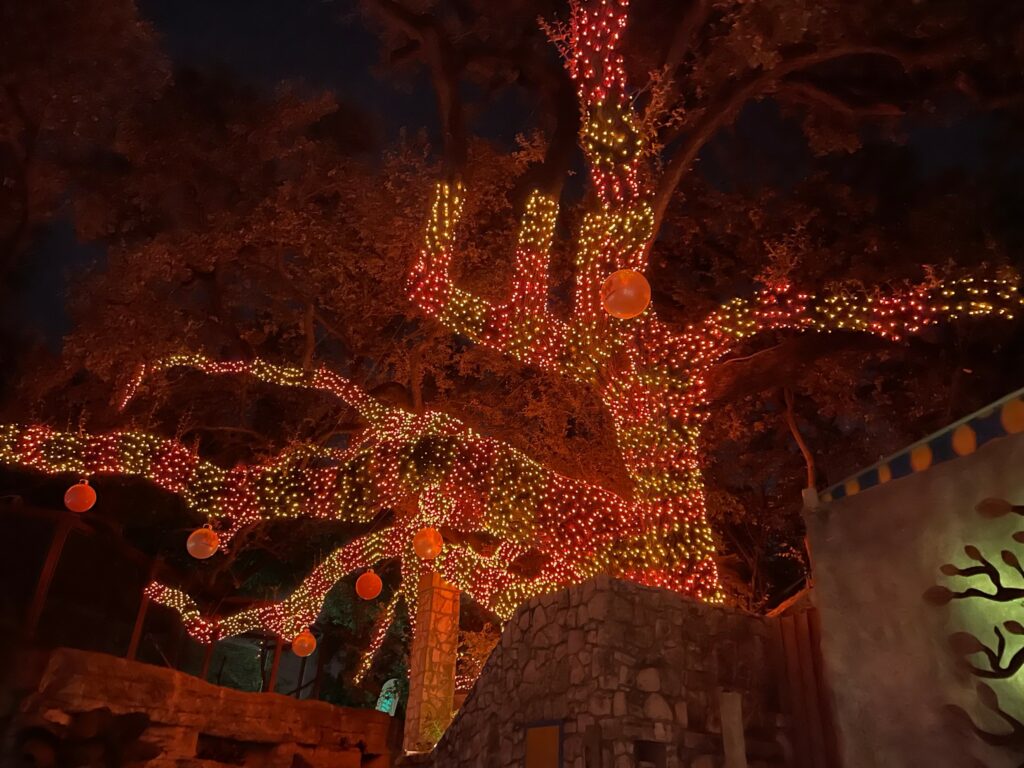Bill Swantner, Bexar County Master Gardener

My family’s Christmas gathering this year was the San Antonio Botanical Garden’s, “Lightscape”. It was an exceptional combination of lights and music. There were lights on the ground, in the air, circling trees and plants. I even saw, “smoke on the water”. (1972 rock song reference.) As I wandered the gardens, seeing these beautiful lights, I remembered the Christmas lights in my neighborhood- some of the displays being rather elaborate.
Outside of the holiday season, some houses have porch lights and flood lights on all night, streetlights dot the streets of subdivisions, and other homes are incorporating their own, smaller version of, “light-scaping” to enhance the nighttime beauty of their property. And I wondered, does this artificial lighting at night affect the plants in the landscape? Holiday lights are up for a short time but, flood lights, porch lights, street lights, and “light-scaping” are more permanent. Can this source of artificial light during dark hours affect flowers, trees, and turfgrass? Generally speaking, “it depends”, but it’s quite possible that artificial sources of light at night can be detrimental to landscape plants.
The research says, “it depends” because there are many types of artificial lights, and plants have differing sensitivities to light. In his article, “Does Night Lighting Harm Trees?” William R. Chaney, Department of Forestry and Natural Resources, Purdue University, lists five sources of artificial lighting and their potential effects on trees.[1] His conclusion is that night lights can have an adverse effect on trees. The two determining factors are the type of light and the sensitivity of trees to the color spectrum of the light.
In her article, “The Myth of Night Light: Unless You’re a Poinsettia, Increased Light Can’t Hurt””, Linda Chalker-Scott, Ph.D., Extension Horticulturist and Associate Professor, Puyallup Research and Extension Center, Washington State University writes, “As the summer continues, day length shortens, and nights lengthen. Temperate plants cue into this shift, and at a particular light to dark ratio, will initiate biochemical changes to prepare for winter dormancy. An uninterrupted dark period is critical for this process as well as for flower bud initiation in certain plants.”[2]
In a December 4, 2018 article entitled, “Are you Photoperiodic? Poinsettias Are”,
David Graper, Professor Emeritus of Horticulture Science, South Dakota State University, writes, “Many plants are photoperiodic. They rely on cues from nature, like the shortening day or night to make changes in how they grow. They may switch from producing leaf buds to producing flower buds. Many of our deciduous trees use the shortening day lengths to trigger the development of fall leaf color and leaf drop. Some vegetable crops, like onions, use our long day lengths in the summer to stimulate the development of the bulb of an onion.”[3]
In doing research for a Poinsettia presentation, this writer spoke with one of the most experienced growers at Peterson Brothers about night lights and growing poinsettias. He said that poinsettias can handle moonlight; it’s the artificial sources that can create problems.
So back to the original question, “Does artificial light at night have an effect on plants?” and the answer is, “It depends, but, it might.” It depends on the type of the light and the sensitivity of nearby plants to the source of the artificial night light. Sometimes lights at night are needed as a deterrent to crime; sometimes outside lighting is needed for safety reasons. In those areas where lighting is necessary or, if a homeowner wants to add lightscape to their landscape, additional research should be done on the type of light being emitted and the light sensitivity of plants in that area.
[1] https://www.extension.purdue.edu/extmedia/FNR/FNR-FAQ-17.pdf
[2] https://s3.wp.wsu.edu/uploads/sites/403/2015/03/light-pollution.pdf
[3] https://extension.sdstate.edu/are-you-photoperiodic-poinsettias-are#:~:text=Photoperiodicity%20in%20plants%20continues%20to%20be%20a%20common,photoperiodic%20response%20than%20the%20common%20poinsettia%20or%20chrysanthemum.
